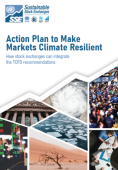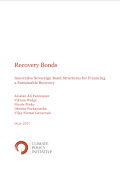
This document provides a practical action plan and bespoke guidance on creating climate-resilient markets to help stock exchanges lead a transition to more climate-resilient markets using the various tools available to them.

This paper assesses the potential for recovery bonds to help sovereigns raise capital to fund a sustainable and climate-resilient post-COVID recovery. As climate impacts become more severe, countries need targeted approaches to capital borrowing and deployment that is designed to decrease emissions, increase renewable energy distribution and other climate mitigation and adaptation solutions, and create long-lasting green jobs for a secure economy.

This report aims to advance the climate change aspects of the World Bank's green, resilient and inclusive development (GRID) approach, which pursues poverty eradication and shared prosperity with a sustainability lens. Specifically, the action plan supports countries and private sector clients to maximize the impact of climate finance, aiming for measurable improvements in adaptation and resilience and measurable reductions in greenhouse gas emissions.
Flood and drought disasters impose a huge toll: Over the last two decades, at least 1.65 billion people have been affected by floods and 1.43 billion by droughts. A new perspective, referred to as an "EPIC Response," is offered to better manage hydro-climatic risks: This perspective looks at floods and droughts not as independent events but rather as different ends of the same hydro-climatic spectrum that are inextricably linked.
NGFS and INSPIRE have established a joint Study Group on Biodiversity and Financial Stability, with the aim to understand the potential implications of biodiversity loss for financial stability.
